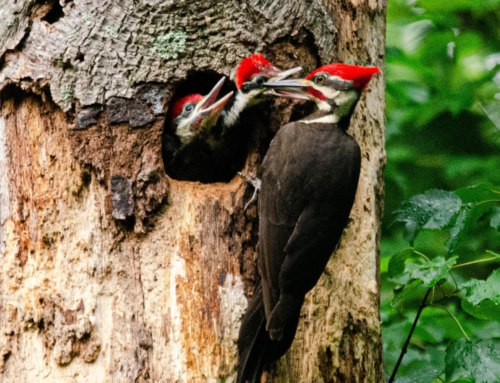Teacher-Teacher-TEACHER-TEACHER! is how their song is usually described. This Ovenbird, however, was not singing. It was sending furious loud chips my way from just a few feet above my head and not five yards into the woods. As it angrily looked down at me, hackles raised, it darted from one limb to another in the dense foliage. It was early June. There must be a nest and likely young birds nearby. I looked around for fledglings but saw none. I looked for an Ovenbird’s nest. Notoriously difficult to find, an Ovenbird nest is a dome-shaped pile of leaves hidden on the forest floor in the deep leaf litter. The nest’s resemblance to an oven gives this species its common name. I’ve never been able to find an Ovenbird’s oven and I still haven’t.
My little friend had expended a lot of energy defending against my intrusion so I quickly took a couple backlit photos, got a passable recording on my phone and moved on having clearly overstayed my welcome. The victorious bird ceased its tirade after I had gone no more than 10 yards down the path.

I was walking along Rocky Run Trail not far from the gate near the pond at Tyler. I was at the end of a two-hour solo birding walk. The heat and humidity were building rapidly and my water bottle was in the car instead of my pocket. The deep shade was some relief from the heat of the sun in the meadows but the humidity in these dense woods was becoming oppressive. Uncomfortable as it might have been to me, this is habitat where Ovenbirds thrive and find what they need to survive as a species.
Ovenbirds are not rare. Their loud, emphatic calls are one of the most common sounds heard in mature forests east of the Rockies and they sing well into the summer breeding season. It is not uncommon to be able to stand in the woods during spring migration when the birds are establishing territories and hear four or five Ovenbirds calling at the same time. But they are way, way more easily heard than seen.
The Ovenbird’s most distinguishing physical features are its handsome orange cap bordered by two black lateral crown stripes. They sport prominent eye rings that give them a bug-eyed look. The Ovenbird’s olive-brown back and heavy black streaking on a white breast are very thrush-like and, like a thrush, they blend easily into the leafy, dense forest. A birder can spend many minutes standing in front of a tree from which a teacher-teacher call is ringing and more often than not the birder’s patience will run out before the bird is located. The Ovenbird is not a thrush, it is classified as a wood warbler and other than flying up to a tree limb to sing it stays primarily on the ground for feeding and nesting, not what we think of as typical warbler behavior. The scientific name for the species is Seiurus aurocapilla. Aurocapilla is derived from Latin and means “golden haired” and Seiurus is from Ancient Greek seiō, “to shake”, and oura, “tail”. I love it.

In breeding season Ovenbirds feed on arthropods that live under the thick leafy forest floor. They need this protein and fat-rich food source to raise their young and to fatten up for their fall migration journey to south Florida, the Caribbean, Mexico and Central America. Ovenbirds feed 88% of the time on the ground and the rest in low shrubs or saplings. Their favorite foods are pretty much anything they find under the leaves: weevils, beetles, caterpillars, ants, and a variety of other bugs and larvae.
According to Cornell’s Birds of the World online Ovenbirds have become a model for studies of the effects of forest fragmentation and habitat loss. The species is very sensitive to habitat fragmentation because its food source, the arthropods, thrive in the humid thick leafy floor of the summer woods and arthropod abundance diminishes near any forest edge. Distance from forest edges also helps protect Ovenbird nests from ground predators and brood parasitism (cowbirds).
Birds of the World states:
The future success of Ovenbirds appears to depend on the continued existence of large areas of core habitat, especially the Ozarks, Appalachia, Pennsylvania, New England, northern Wisconsin, and Quebec and Ontario.
The mature, hardwood/coniferous forest preserved by Tyler Arboretum and the adjoining Ridley Creek State Park provides a haven for nesting Ovenbirds and the continued preservation of large contiguous swaths of these woods is vital to allowing this species, and the food chain of which it is a part, to thrive.
Robert Frost knew best how to describe the value of Ovenbirds to our world in his poem The Oven-bird:
There is a singer everyone has heard,
Loud, a mid-summer and a mid-wood bird,
Who makes the solid tree trunks sound again.
By helping preserve the Ovenbird’s vital habitat, organizations like Tyler Arboretum will help keep the solid tree trunks sounding.






